Afghanistan Travel Guide
This is an Afghanistan Travel Guide from taste2travel.com
Date Visited: August 2023
Introduction
Welcome to Afghanistan, a land where history, culture, and breathtaking landscapes converge to create an unforgettable travel experience.
While I had always dreamed of visiting this Asian jewel, and for many years had travelled along its borders, including in China, Pakistan, and Tajikistan, I was content to view Afghanistan from the safety of a neighbouring country.
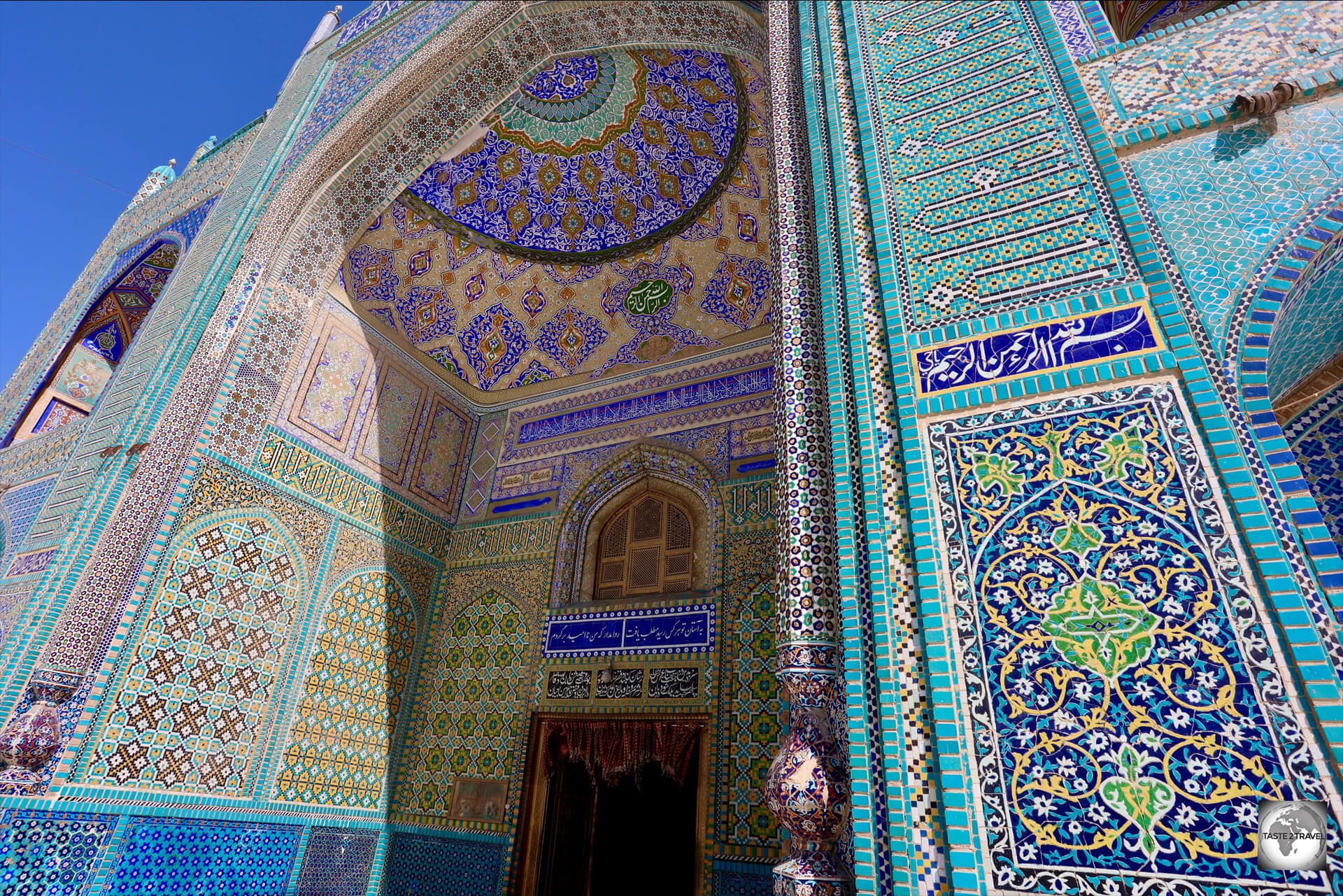
The stunning Blue Mosque, in Mazar-i-Sharif, is made of blue hues of highly detailed mosaic tiles, inspired by Persian design.
For most of my lifetime, the news headlines emanating from Afghanistan were very negative and menacing, and still remain so today. Afghanistan has an image problem that not even the most adept PR company could hope to change.
For this reason, I had relegated a visit to Afghanistan to the ‘too-hard-basket‘.
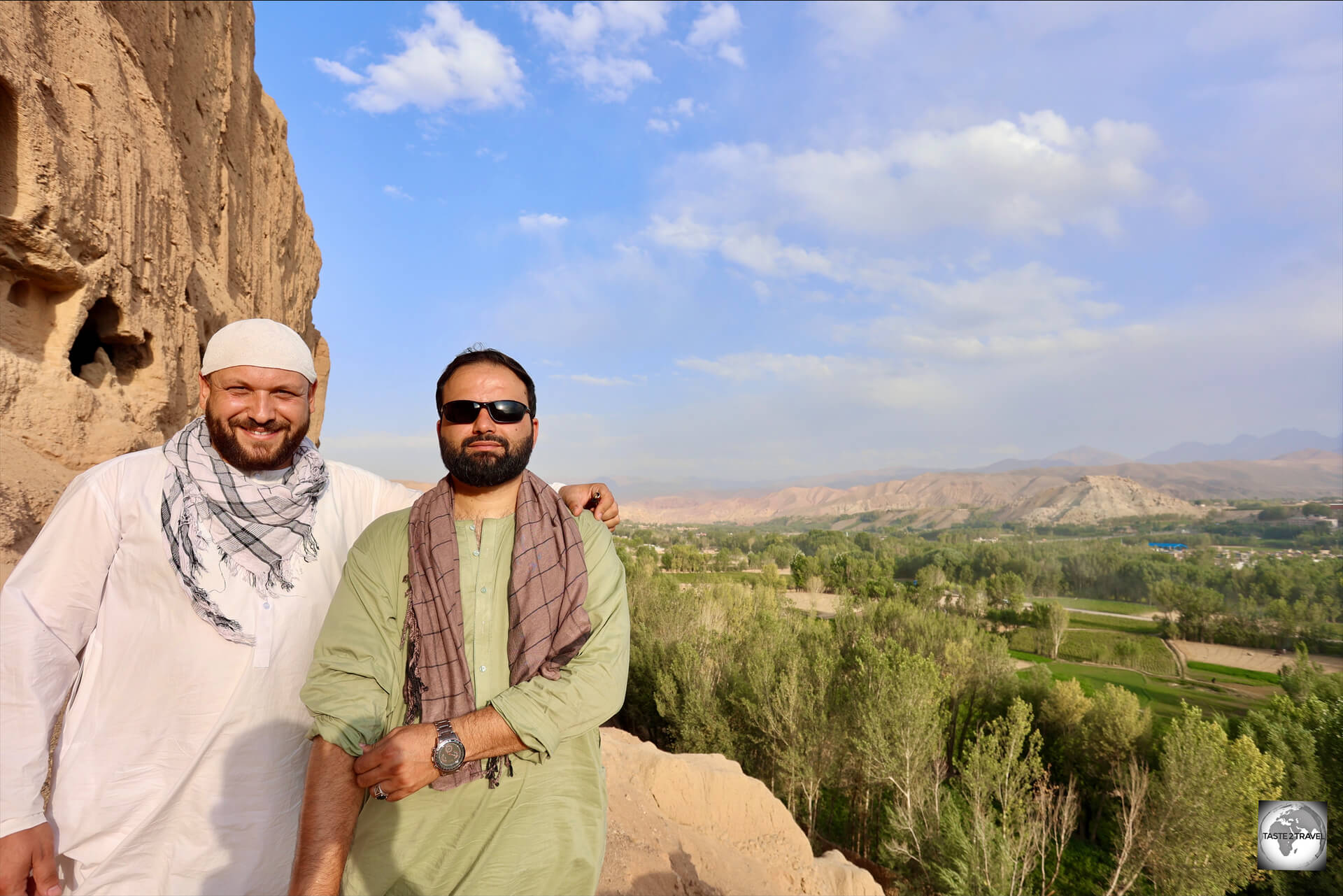
Visiting Bamyan, with my informative guide, Jamshyd Aryan and our driver, Omar.
However, after visiting almost all the countries and territories of the world, including many former conflict zones, I decided to bite the bullet (no pun intended) and plan a visit!
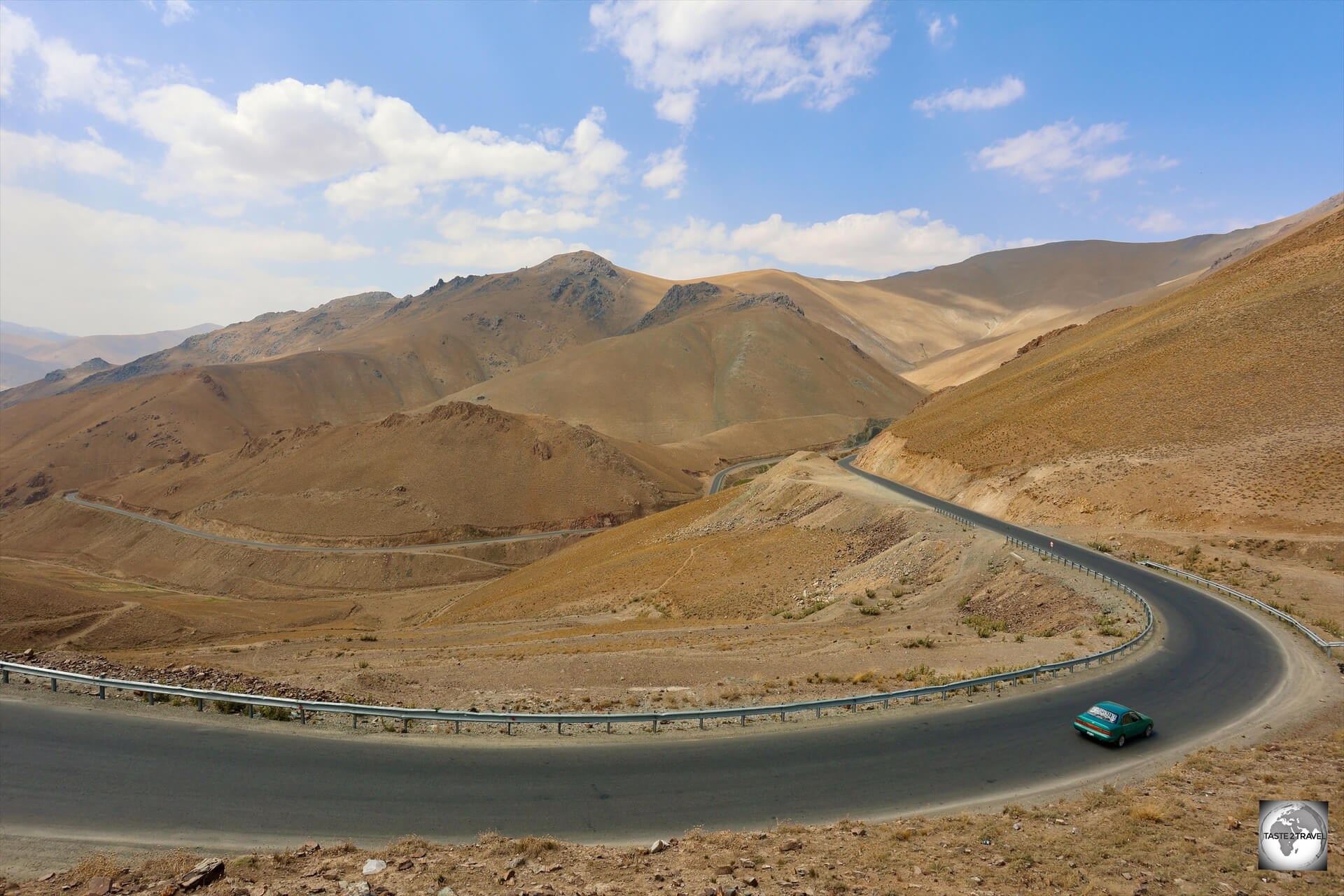
Road trips in mountainous Afghanistan offer incredible views.
Since August of 2021, when the Taliban swept to power, and hugely embarrassed the US Military, who beat a hasty retreat, leaving behind an arsenal of the world’s most impressive weapons, the situation on the ground has changed significantly.
At that time, the former Islamic Republic of Afghanistan become the Islamic Emirate of Afghanistan, with the much-maligned Taliban forming a government.

The stunning Blue Mosque is a highlight of Mazar-i-Sharif.
One of the main priorities for the Taliban has been to restore a sense of safety and security to the country which had become a lawless land.
While almost everyone I spoke to does not accept the rule of the Taliban, who have an unfortunate habit of issuing draconian decrees, absolutely everyone agreed that they feel much safer and more secure due to the hardline the Taliban take against any criminal behavior.
As part of their security measures, all tourists to Afghanistan will only be issued with a tourism visa through the sponsorship of an Afghan-registered tour company.

The imposing walls of Herat Citadel.
Once inside the country, tourists, who must be accompanied by a guide, must report to the Department of Culture in each province they visit (there are 34 provinces in Afghanistan), where they will be issued with a ‘Travel Authorisation‘ for that province.
This authorisation will be requested whenever you visit a tourist sight, and at the numerous roadside checkpoints. Without this authorisation, you will have difficulties to move around the country.
An onerous, time-consuming task, this is done in the name of security! More information on this process is included in the ‘Visa Requirements‘ section below.
Recent Turmoil

A captured Soviet helicopter at the Jihad Museum in Herat.
While Afghanistan has a rich, complex history spanning thousands of years, Afghanistan’s recent history, since 1979, when the Soviet Union invaded to prop up a sympathetic government, has been dark and often violent.
The Jihad Museum in Herat, which details the period surrounding the Soviet invasion and occupation of Afghanistan, includes captured Soviet weapons such as helicopters and fighter jets.
The Soviet army’s 1989 withdrawal was followed by a civil war and domination by warlords.
That in turn gave rise to the Taliban, which seized power shortly before it was toppled by a U.S. invasion in retaliation for the Sept. 11, 2001, terrorist attacks.

A hand-woven Afghan carpet, commemorating “Operation Enduring Freedom”, on sale in a souvenir shop in Herat.
The 2001 terrorist attack on the World Trade Centre in New York City led to the commencement of ‘Operation Enduring Freedom’, the United States’ global War on Terror, which was fought in several countries, but primarily Afghanistan.

A view of the ceiling of the Gawhar Shad Mausoleum in Herat.
This operation began in October 2001 with the invasion of Afghanistan to dismantle the Taliban regime and eliminate al-Qaeda’s presence in the country. It involved a coalition of U.S. forces and international partners, including NATO.
Operation Enduring Freedom continued for many years, and its scope expanded to include counterinsurgency efforts against the Taliban, training and equipping Afghan security forces, and counterterrorism operations.
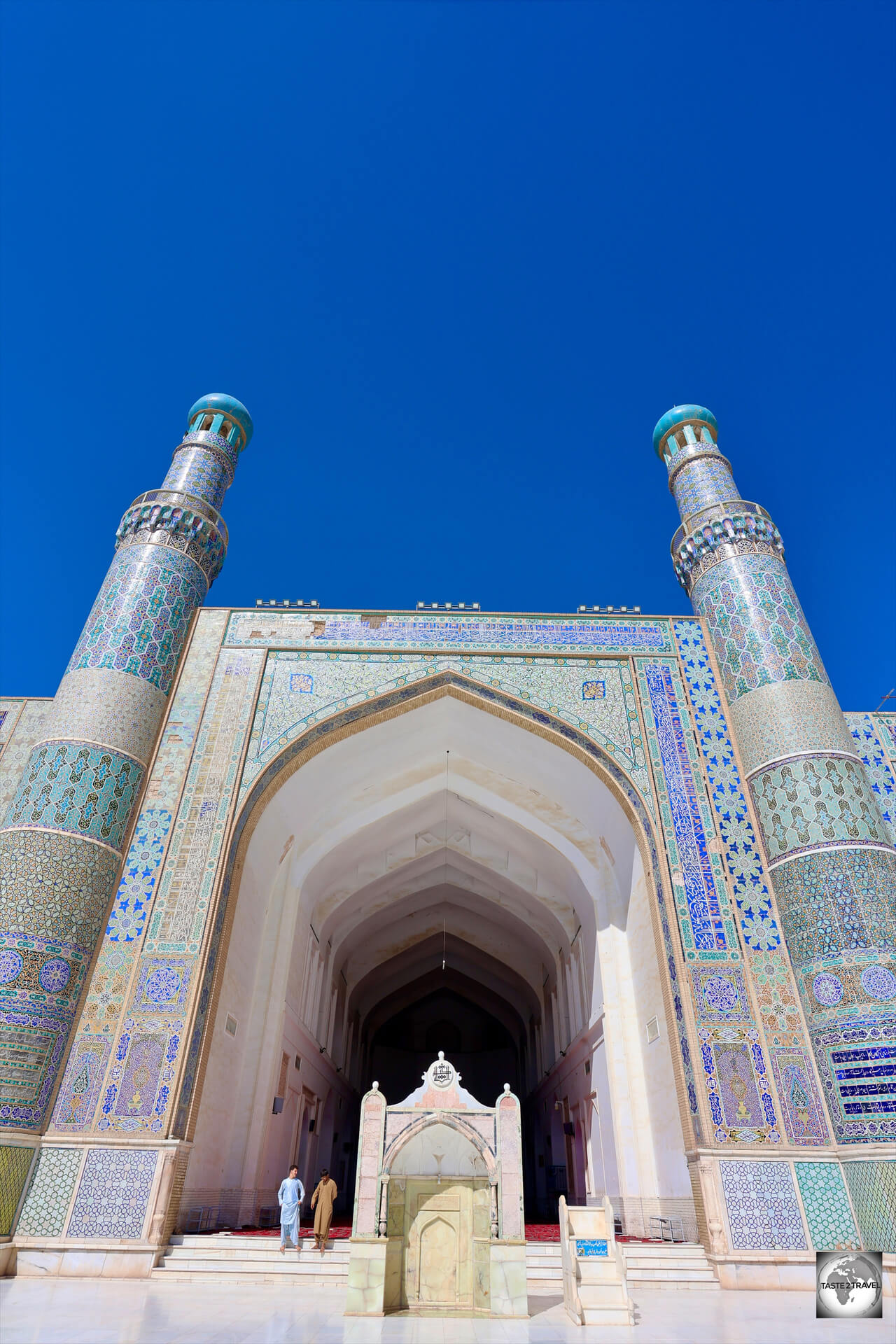
A view of the Great Mosque of Herat.
Eventually, the United States and NATO forces completed a very messy and hurried withdrawal from Afghanistan on August 31, 2021.
Since then, the Taliban have been in power, with the world waiting and watching to see what happens next in Afghanistan.
Conclusion
Afghanistan may not be a typical travel destination, but it offers intrepid travellers a chance to discover a land where history, culture, and natural beauty intertwine with the resilience of its people.

Colourful rolls of hand-woven cloth for sale at Herat bazaar.
While travel here requires careful planning and awareness of the evolving security situation, the rewards are immense for those who embark on a journey to this unique destination.
If you do travel here, you should be prepared to see Taliban carrying their fully loaded AK-47s everywhere.
Whether meeting with the Taliban in a government office, to dining alongside them in a restaurant, guns are everywhere. They are always armed and ready to defend themselves against an attack!
Likewise, checkpoints throughout the country are numerous and often feature heavily armed Taliban and armoured, ex-US military, Humvees.

The empty niche, which was once occupied by the Eastern Buddha at Bamyan.
I look forward to returning again one day to Afghanistan as I feel I have simply scratched the surface of what is a complex, and immensely rewarding, travel destination.
Safety & Security
Afghanistan is a country with a troubled past, a country which has, and still does, face significant security challenges.
Most governments around the world advise against all travel to Afghanistan and regular travel insurance policies do not provide coverage for Afghanistan.
For many decades, the news headlines coming from Afghanistan have been very negative.
Most people would never consider travelling to Afghanistan and, while most Afghans agree that the security situation has improved under the Taliban, most outsiders wouldn’t consider travelling to a country which is controlled by the Taliban.
I spent 11 days in Afghanistan and, at no point, did I feel unsafe or in danger. While most Afghans do not recognise the rule of the Taliban, almost everyone I spoke to agreed that the security situation under the Taliban is the best it has been in decades.
This is due to the fact that the highly armed Taliban are highly visible on the streets, with checkpoints everywhere. Thanks to the US Military, who beat a hasty retreat from Afghanistan, the Taliban have use of the latest US weapons and lots of fully armed Humvees. All of this impressive hardware is on full display at the many checkpoints.
The message from the Taliban is clear – do not step out of line! The days of rogue operators kidnapping foreigners has past, as kidnappers know they will be shot if caught.
Security has been achieved at the barrel of the gun – which is invariably an AK-47!
In each province, as a foreigner, I had to meet with the Taliban and obtain a Travel Authorisation (please refer to the Visa Requirements section below for more on this process) in order to visit the province.
In each meeting, I was greeted with respect and kindness. I was welcomed to Afghanistan and asked if I felt safe.
Security and safety are a big priority of the Taliban. I was told that the supreme leader has issued a decree to all Taliban that foreigners must be treated kindly and with respect. I can concur that most of the Taliban are following this directive.
Afghanistan is still very much in a state of flux and, while the Taliban would like to see more tourists visiting, the damage to the image of Afghanistan is so great that most potential tourists will not be planning a visit anytime soon.
The Taliban seem keen to be accepted by the world at large. However, it seems the only legitimate path forward for the Taliban is that they become a political party and then contest free and fair elections.
I would recommend Afghanistan to those intrepid travellers who have experience visiting other conflict zones.
While in the country, you will see lots of heavily armed Taliban (including sitting in their offices nursing their AK-47s), lots of armed vehicles and you will need ample patience as you negotiate the many, many checkpoints, body searches etc.
Location
Afghanistan is a landlocked country located in South Asia, Central Asia, and Western Asia. Its geographical location places it at a crossroads of several important regions and countries. Here’s a description of Afghanistan’s location:
Afghanistan is often considered a part of Central Asia, as it shares borders with several Central Asian countries, including Turkmenistan, Uzbekistan, and Tajikistan to the north. These mountainous and often rugged borders define Afghanistan’s northern boundary.
To the south, Afghanistan shares a border with Pakistan, which is classed as South Asia. The border between Afghanistan and Pakistan is a long and historically significant one, with multiple crossing points.

An incredible handwoven carpet in a restaurant in Mazar-i-Sharif features a map, and flags, of the world.
To the west, Afghanistan shares a border with Iran, which is classed as West Asia. Afghanistan was once part of the Persian empire and shares significant cultural and historical ties with Iran. The border with Iran extends through the western part of Afghanistan.
To the east, Afghanistan shares a relatively short border with China, which is part of East Asia. This border is located in the northeastern part of Afghanistan, in the Wakhan Corridor.
Afghanistan is characterised by its rugged and mountainous terrain, with the Hindu Kush mountain range running through the central part of the country.
This mountainous geography has historically contributed to Afghanistan’s isolation and played a role in shaping its culture and history.

On the road to Bamyan, Afghanistan.
One significant geographical feature of Afghanistan is that it is a landlocked country, meaning it has no coastline. Despite its lack of access to the sea, Afghanistan’s location at the crossroads of various regions has made it strategically important throughout history.
Afghanistan’s geographical location has both advantages and challenges. Its position has made it a historical trade and cultural crossroads, but it has also been a region of geopolitical significance, which has contributed to its complex history and political dynamics.
People

Two Pashtun men, exploring the ancient city walls in the town of Balkh,
The people of Afghanistan are a diverse and ethnically rich population with a long history and a unique cultural heritage.

Like many of the inhabitants in Mazar-i-Sharif, my guide (right) and driver were from the Turkmen ethnic group.
Afghanistan is known for its ethnic diversity, with several major ethnic groups, including:
- Pashtuns: Pashtuns are the largest ethnic group in Afghanistan, and they have a significant presence in both urban and rural areas. They speak Pashto and have a strong cultural influence in the country. The members of the Taliban are predominantly Pashtuns.
- Tajiks: Tajiks are another major ethnic group in Afghanistan, primarily living in the northeastern and western parts of the country. They speak Dari (a variety of Persian) and have a rich cultural history.
- Hazaras: Hazaras are a predominantly Shia Muslim ethnic group with a distinct Central Asian appearance. They primarily inhabit the central highlands of Afghanistan.
- Uzbeks, Turkmen, and Baloch: These ethnic groups have smaller but significant populations in Afghanistan, often concentrated in specific regions.

While photographing older woman is not allowed in Afghanistan, younger girls are happy to be photographed.
The official languages of Afghanistan are Pashto and Dari (Persian). However, due to the country’s ethnic diversity, many other languages and dialects are spoken across the nation.
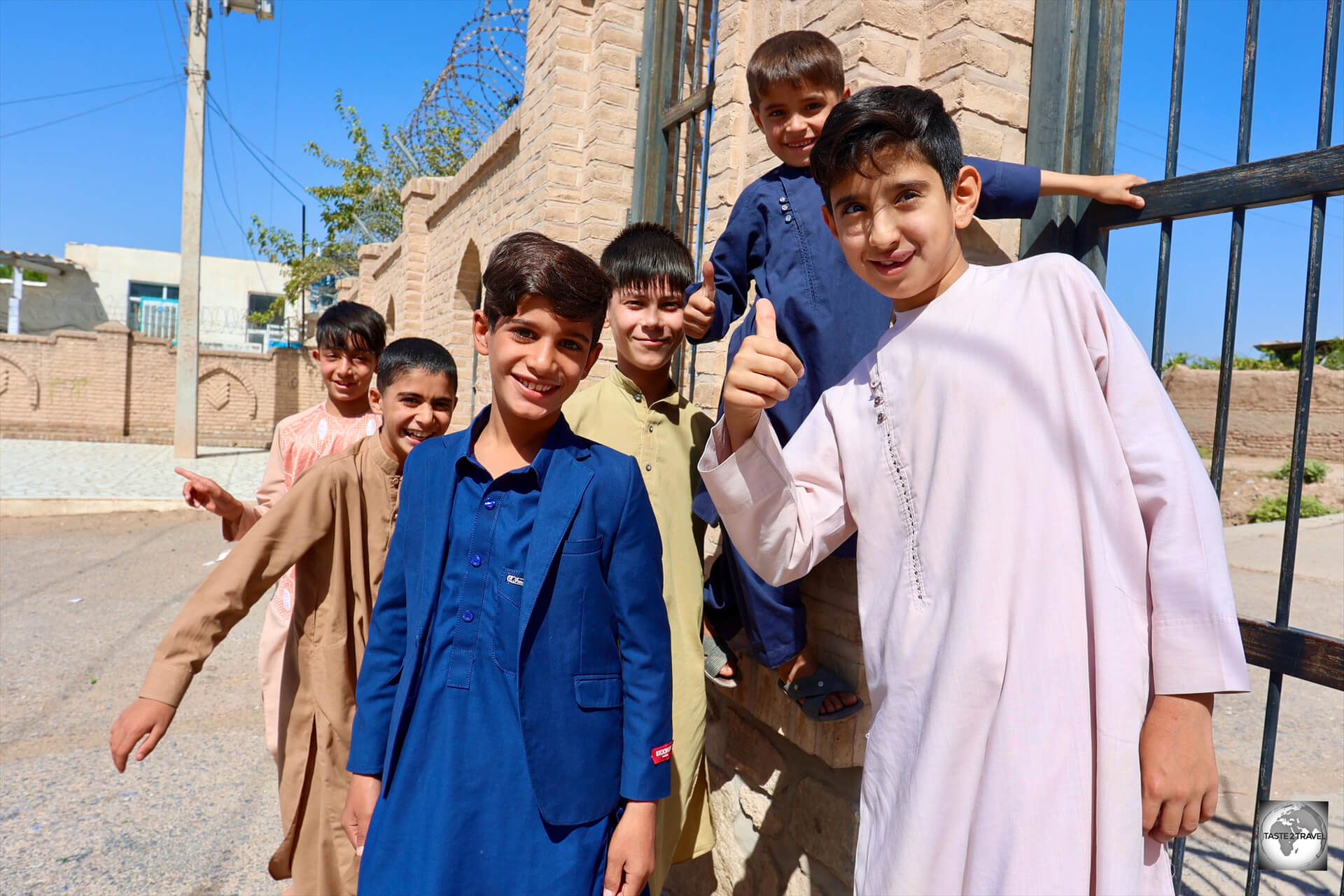
Young boys in Herat.
The vast majority of Afghans are Muslims, with Sunni Islam being the predominant branch. There is also a significant minority of Shia Muslims, primarily belonging to the Hazara ethnic group.

A young boy in Bamyan.
Afghan society traditionally places a strong emphasis on family and community values. Extended families often live together, and there is a strong sense of hospitality towards guests.
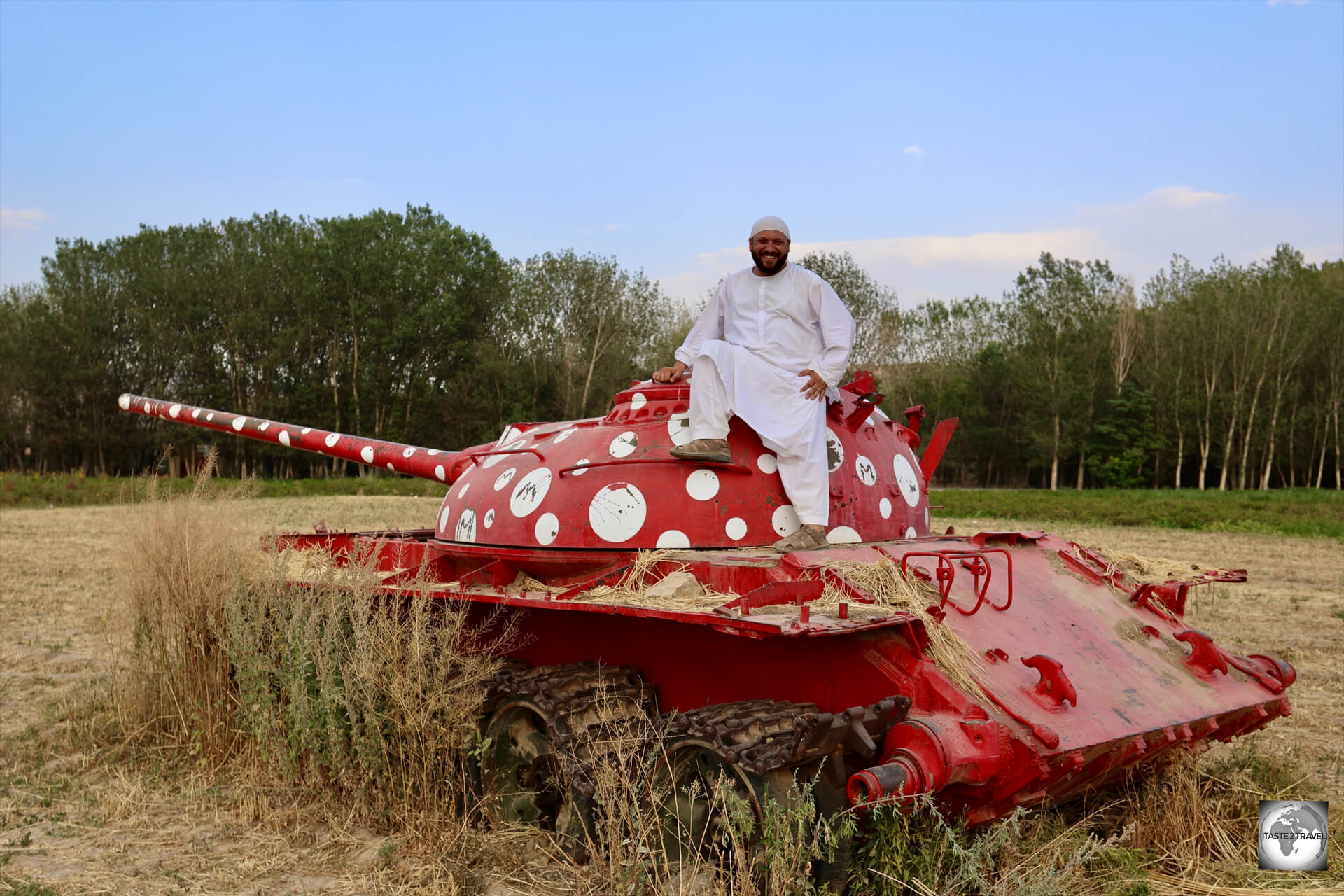
My guide in Kabul and Bamyan, Jamshyd, is a member of the Tajik ethnic group.
Female Travellers
While Afghanistan is a complicated travel destination, female travellers have to contend with an added layer of complexity which comes from not only being in an Islamic country, but being in a country where the (repressive) Taliban set the rules.
While as a solo male traveller, it’s difficult for me to relate to the female experience, I can offer some observations from what I experienced.
Observation 1:
Hijab must be worn by all females at all times!
When I was leaving Bamyan, we had to make the obligatory stop at the checkpoint on the outskirts of town. All checkpoints are manned by Taliban soldiers.
At the checkpoint, a religious policeman was advising a family, who were arriving in their car, that the nearby lake, Band-e Amir, was currently off limits to females.
This was due to a decree which had been issued by the supreme leader of the Taliban, banning female visitors to the lake, after some girls were found at the lake a couple of days earlier, without hijab!
Observation 2:
While at Bamyan, I was surprised to meet an Australian-Afghani family who were on holiday from Melbourne. They were excited to meet a fellow Australian in Afghanistan.
I offered for us to have a photo together in front of the giant Buddhas. The family thought this was a good idea but were then reminded of the Taliban rules – which prohibit females from interacting with males who are not family members.
In the end, they declined my offer, but allowed their younger daughter to have a photo with me!
Observation 3:
While entering the Blue Mosque in Mazar-i-Sharif, the Taliban security guards asked my guide if I was travelling with any female companions.
The reason for this question was that the Taliban have a schedule for female visitors, and on the day, I was visiting, female visitors were not allowed inside the mosque compound.
For female visitors, I would highly recommend either travelling on an organised group tour or with a male companion.
Flag

The flag of Afghanistan.
Official Flag of Afghanistan
The official flag of Afghanistan consists of three vertical stripes arranged from left to right: black, red, and green.
Black Stripe: The black stripe represents the dark past of Afghanistan. It symbolises the difficult and challenging periods in Afghanistan’s history.
Red Stripe: The red stripe represents the bloodshed and sacrifices made by Afghan people in their struggle for independence and freedom.
Green Stripe: The green stripe signifies hope for a bright future and prosperity for the nation. It represents the lush green landscape of Afghanistan and the hope for a peaceful and stable future.
In the centre of the red stripe, an emblem features a mosque with a pulpit and flags on either side, below which are Eastern Arabic numerals for the solar year 1298 (1919 in the Gregorian calendar, which marks Afghanistan’s independence from British influence).
Above the mosque is a pulpit with the Shahada (the Islamic declaration of faith) inscribed on it, below which are sheaves of wheat on either side.
This emblem represents Afghanistan’s Islamic heritage and its aspirations for a prosperous future.
Taliban Flag

The flag of the Taliban at the Blue Mosque in Mazer-i-Sharif.
The flag which is currently flown throughout Afghanistan is the white and black flag of the Taliban.

The flag of the Taliban, alongside the flag of my hotel in Herat.
The flag features a white background with the Shahada (the Islamic declaration of faith) written in black.
Currency

The Afghan Afghani is the official currency of Afghanistan.
The official currency of Afghanistan is the Afghan Afghani, which is often abbreviated as “Afs“. The international currency code for Afghani is ‘AFN‘.
The currency of Afghanistan is issued by Da Afghanistan Bank – the Central bank of Afghanistan.
For those who are keen numismatists, the bank offers an informative PDF-format document which describes the evolution of currency in Afghanistan – covering all series of currency from ancient to modern times.

Featuring the Shrine of Ali at Mazar-i-Sharif, the 1,000 Afghani banknote is the highest denomination note.
Banknotes are issued in denominations of Afs 10, 20, 50, 100, 500, and 1,000.
The Afghani is nominally subdivided into 100 puls, although there are no pul coins in circulation these days.
Costs

Menu prices, at the very fine, Bukhara Restaurant, in Kabul.
While travel costs in Afghanistan are totally reasonable, all visitors must join a tour in order to secure a visa and most tour companies are currently charging around US$300 per day, which is all inclusive.
Sample costs in Afghanistan:
- Single room at the Kabul City Walk Hotel: US$50 per night
- Meal (budget restaurant): US$2
- Meal at Bukhara Restaurant in Kabul (mid-range restaurant): US$5-7
- Cappuccino at Bukhara Restaurant in Kabul: US$1.50
- Return domestic flight with Kam Air – Kabul to Mazar: US$130
Money Exchange
Both forex bureaux and money changers can be found everywhere in the major cities, with many money changers operating on the street.
While the exchange rate changes on a daily basis, during my stay, US$1 = 80 AFN.
Click here to view the current exchange rate.
Sightseeing

The spectacular Blue Mosque in Mazar-i-Sharif is a highlight of Afghanistan.
Kabul
While Kabul served as a base for my trips to Herat, Bamyan and Mazar-i-Sharif, I spent little time in the city.
It seemed I always arrived late into the capital and then departed early the next morning for the next location.
I will cover Kabul on my next trip to Afghanistan.
Mazar-i-Sharif

The beautiful, Shrine of Hazrat Ali, also known as the Blue Mosque, is the highlight of Mazar-i-Sharif.
Nestled in the northern plains of Afghanistan lies the historic city of Mazar-i-Sharif. According to tradition, the city of Mazar-i-Sharif owes its existence to a dream.
At the beginning of the 12th century, a local mullah had a dream in which Hazrat Ali ibn Abi Talib appeared to reveal that he had been secretly buried near the city of Balkh.
‘Mazar-i-Sharif‘, which is named after the Shrine of Hazrat Ali, translates as “the shrine of the magnificent“.
Known as Afghanistan’s Serene City of Spirituality, the famous poet and Sufi mystic, Jalal al-Din Rumi (known simply as ‘Rumi’) was born in the area. Rumi was famous for his poems, and other works, which widely influenced mystical thought, and literature, throughout the Muslim world.

The beautiful entrance to the Shrine of Hazrat Ali in Mazar.
Mazar is famous in Afghanistan for its fine cuisine and for producing the tastiest melons in the country. On my return flight to Kabul, many of my fellow passengers boarded the flight carrying a melon under their arm. It was a sweet-smelling flight!
While Mazar lies just 400 km northwest of Kabul, the journey, on a rough road, takes 9 hours, while flights from Kabul take just 50 mins. Most people chose to fly!
The Blue Mosque (Shrine of Hazrat Ali)

The present-day Blue Mosque dates from the 15th century (CE).
The Shrine of Hazrat Ali, also known as the Blue Mosque, is a mosque located in the heart of Mazar-i-Sharif.
It is one of the reputed burial places of Ali ibn Abi Talib, cousin and son-in law of Prophet Muhammad.
While Shia Muslims believe that the same Imam Ali is buried in a holy shrine in Najaf, Iraq (my Iraq Travel Guide features the shrine in Najaf), Sunni Muslims believe that shortly after the murder of Ali and the burial of his body at Najaf, some of Ali’s followers were worried that his body would be desecrated by his enemies.
To avoid this, they decided to relocate his body by placing his remains on a white female camel.

A view of the western gate at the Blue Mosque.
Ali’s followers traveled with the camel for several weeks, until the camel ultimately fell to the ground exhausted.
The body was then reburied where the camel fell, in present day Mazar. The body was said to be rediscovered there in the 12th century (CE).

The blue Mosque was constructed in a way to make it appear to be floating.
The Shrine was first built in the 12th century (CE), but then destroyed by Genghis Khan in the 13th century (CE), and later rebuilt in the 15th century (CE).

A view of the western gate and the Blue Mosque.
When visiting the Shrine, visitors are required to present their local Travel Authorisation to the mosque guardian who occupies an office at the rear of the mosque.

The Blue Mosque was inspired by classic Persian design elements.
Once you have been registered, you are free to visit the mosque compound, however, due to Taliban restrictions, non-Muslims are not allowed inside the mosque.
Balkh

A view of the countryside around Balkh, from atop the ancient city walls.
A popular daytrip from Mazar is to the nearby ancient city of Balkh, which is located 20 km (12 mi) northwest of Mazar-e Sharif, and 74 km (46 mi) south of the Uzbekistan border.

Afghan boys playing cricket in Balkh. The Afghans love cricket!
Balkh is an ancient city, with a 2500-year long history, situated on the plain between the Hindu Kush Mountains and the river Amu Darya (historically known as the Oxus) in the north of Afghanistan.

The ancient, earthen, city walls still surround the modern town of Balkh.
Balkh was once one of the wealthiest and largest cities of Greater Khorasan.
The city was known to Persians as Zariaspa and to the Ancient Greeks as Bactra, giving its name to Bactria.
A settlement existed at the site as early as 500 BC, and the town was captured by Alexander the Great about 330 BC. Thereafter it was the capital of the Greek satrapy of Bactria.
It was in Balkh that Alexander the Great met his wife, Roxana, a Bactrian princess.
It is said that Alexander married Roxana after invading Persia and after his defeat of Darius, ruler of the Achaemenid Empire. Reportedly, Roxana was a young teenager at the time of her marriage to Alexander.
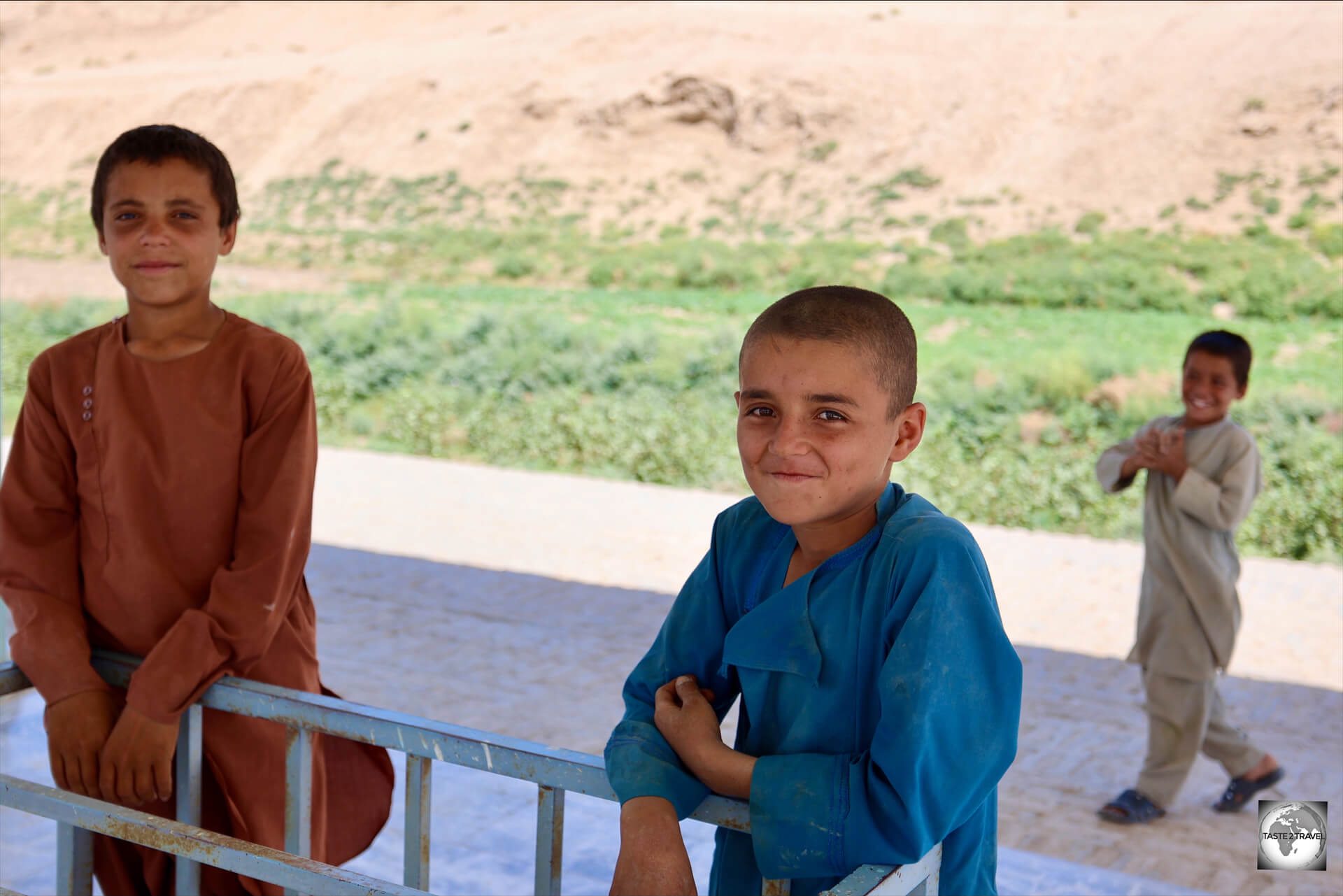
Young boys, at the tomb of the famous scholar Mullah Mohammad Jon in Balkh.
The great wanderer, Marco Polo, once described Balkh as a “noble and great city”.
Today, Balkh is, for the most part, a mass of ruins, with much of its former past buried under metres of mud and dust. A huge excavation project which has yet to be commenced.
The former Citadel, the Bala Hisar, is completely covered by centuries of mud and dust.
The modern town of Balkh, which offers a handful of sights, is home to a population of 140,000 souls.
Video: Travelling from Balkh to Mazar-i-Sharif.
Ancient City Walls

A view from on top of the ancient city walls of Balkh.
Today, the traces of Balkh’s earthen walls can still be seen over a length of some 10 kilometres, to the north of which lies a secondary fortified area, the Bala Hisar.
Lookout points on top of the ancient city walls offer panoramic views of the surrounding, rural, countryside.
Bala Hisar

A curious, lone, tomb is installed on the former earthen wall of the Bala Hisar.
The Bala Hisar (former citadel) of Balkh is a fortified area within the larger walled enclosure of Balkh situated to the north of the modern city.

The guardian of the lone tomb at the Bala Hisar.
Abandoned today, the area marks the original location of the city of Balkh before its expansions in the Greek, Kushan, and Islamic periods.
The circular enclosure wall with half-round ramparts that stands today dates to the reoccupation of the site during the Timurid period in the 14th century (CE).
Mosque of Nine Cupolas

The ‘Mosque of Nine Cupolas’ is a UNESCO World Heritage Site.
Located in the ancient town of Balkh, the Haji Piyada Mosque (“Mosque of Nine Cupolas”) is a Samanid-style building which dates from the 9th century (CE).
The mosque is thought to be the earliest Islamic building in the country.
Carbon dating conducted in early 2017, together with historical sources, suggest it could have been built as early as the year 794, on the site of a former Zoroastrian temple.

The ‘Mosque of Nine Cupolas’ is believed to have been built on the site of a former Zoroastrian temple.
The interior is divided into nine bays, each originally covered by a dome – the nine cupolas.
The columns and the arches that divide the bays are decorated in deeply carved stucco, depicting a wide variety of designs, stylistically comparable to Abbasid decoration in Mesopotamia.

The ‘Mosque of the Nine Cupolas’ features deeply carved stucco design.
Pilgrims visit the tomb of saint, Haji Piyada, who was also buried there.
As part of conservation efforts, in 2011, a large temporary metal roof was constructed in order to protect the site from rain, wind and other natural disasters.
In order to visit the mosque, which is locked behind a security fence, your guide will need to seek permission from the Taliban guards who can be found in an office at the front of the property.
They will want to see a copy of your travel authorisation from Mazar and will want to keep a photocopy of the document. Since we didn’t have a copy, we had to drive the Taliban guard into town to get a copy then drive him back to the mosque – a 10 km roundtrip.
Khwaja Abu Nasr Parsa (Green Mosque)
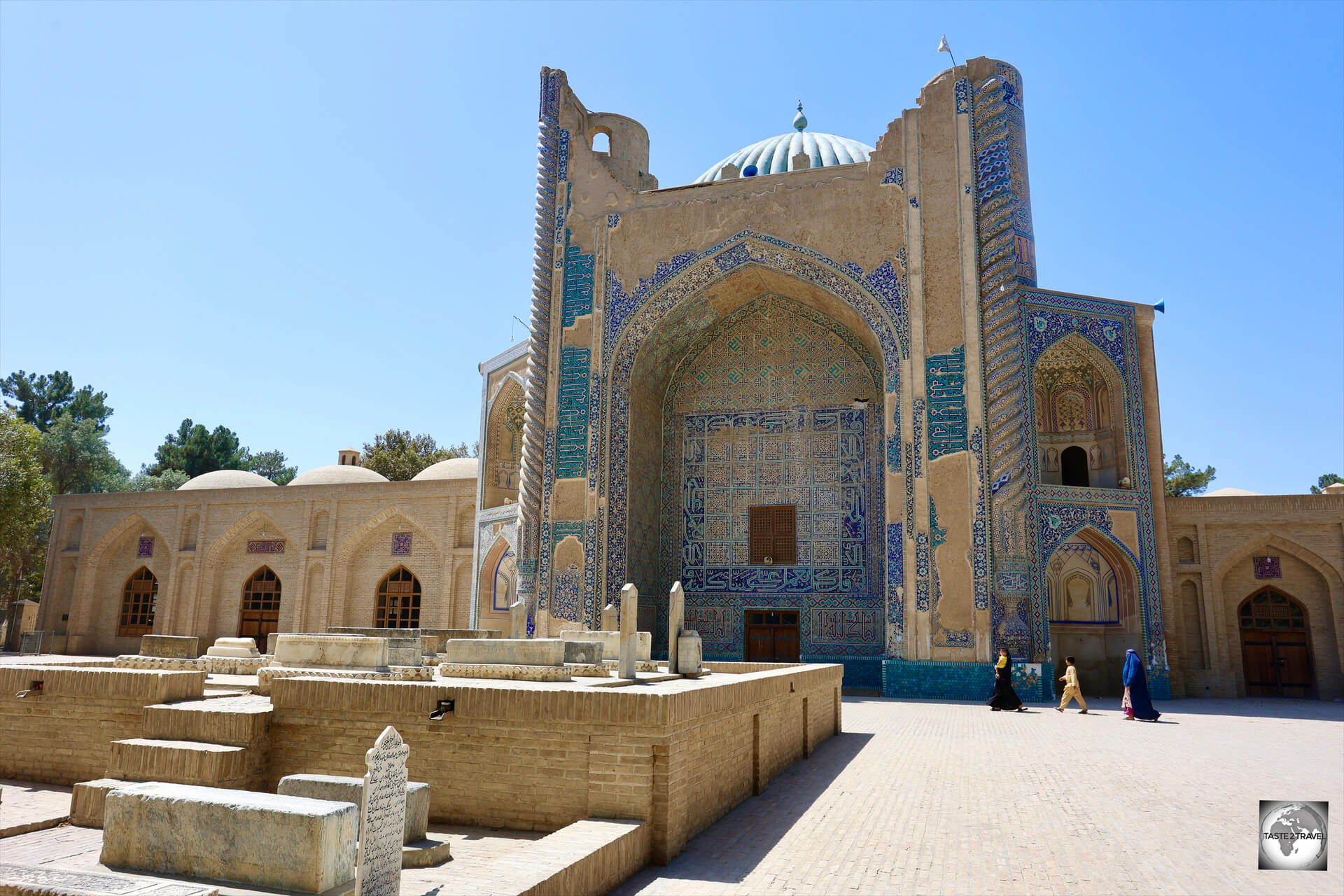
The Green Mosque in Balkh, where Abu Nasr Parsa is buried.
Located in the centre of a leafy, green park in downtown Balkh, the Green Mosque is the burial place of Khwaja Abu Nasr Parsa (died 1461), a 15th-century Sufi mystic.
The shrine was built around 1598 and has an octagonal plan of two stories with axial Iwans and corner rooms.

A view of the entrance to the Green Mosque in Balkh.
Khwaja Abu Nasr Parsa was a spiritual leader of the Naqshbandi order and a theological lecturer in Herat.

A view of the very dilapidated Khwaja Abu Nasr Parsa (Green Mosque) in Balkh.
Today, the mosque has suffered heavily from neglect and damage by warring factions during the Soviet and Afghan civil wars.
The minaret has either collapsed due to the age of the building or could have been the act of aggression during wartime by the communists. Much of the tile work has disappeared and everything is in dire need of repair.
Visiting inside the mosque is not allowed.
Tomb of Rabia Balkhi

The tomb of Rabia Balkhi, a celebrated, 10th century, female poet.
Located in the same park, in front of the Green Mosque, is the sunken Tomb of Rabia Balkhi.
Rabia Balkhi was a 10th-century writer, who composed poetry in Persian and Arabic. She is the first known female poet to write in Persian.
Sadly, Rabia was a victim of an honour killing by her brother Hareth, after she fell in love with one of her brother’s slaves. She apparently wrote her last poems in her own blood.
After her death, all her poems were destroyed by her brother. Her tomb has become a spiritual place for Sufis.
Herat

A view of the front entrance of the Great Mosque of Herat.
Welcome to Herat, a city that embodies the essence of Afghanistan’s rich cultural heritage. Known as the “Pearl of Khorasan” and celebrated for its stunning architecture, vibrant bazaars and its imposing citadel.

Worshippers at the Great Mosque of Herat.
UNESCO is presently considering the nomination of Herat as a World Heritage Site.
Great Mosque of Herat

The white marble courtyard of the Great Mosque of Herat, with a view of three of the four Iwans.
Known also as the Herat Central Blue Mosque, or the Friday Mosque, or the Jami Masjid of Herat, this mosque lies at the heart of the city, surrounded on all sides by a sprawling, bustling and fascinating bazaar.

A view of one of the Iwans at the Great Mosque of Herat.
The Great Mosque of Herat was the city’s first congregational mosque. It was built on a site where religious temples had been located for many centuries.

Like most ancient mosques in the region, the Great Mosque of Herat was built over a former Zoroastrian temple.
The first known building was a Zoroastrian temple, which was converted into a mosque in the 7th century.

Detail of tilework at the Great Mosque of Herat.
Afterward, it was enlarged by the Turkic Ghaznavids. The mosque was built by the Ghurids, under the rule of Sultan Ghiyath al-Din Muhammad Ghori, who laid its foundation in 1200 CE.

A stone memorial marker is installed outside the entrance of the Great Mosque of Herat.
The Ghurids built the entire mosque using brick. The layout is a typical 4-iwan plan with an interior courtyard and a water basin.

A view of the Great Mosque of Herat.
Later, it was extended several times as Herat changed rulers down the centuries from the Kartids, Timurids, Mughals and then the Uzbeks, all of whom supported the mosque.

A view of the main Iwan at the Great Mosque of Herat.
The fundamental structure of the mosque from the Ghurid period has been preserved, but parts have been added and modified. The mosque was given its present appearance during the 20th century.

A view of the back entrance of the Great Mosque of Herat.
Access to the mosque is granted by Taliban security guards after they have reviewed your travel authorisation, which is issued by the Department of Culture in Herat.
Herat Citadel
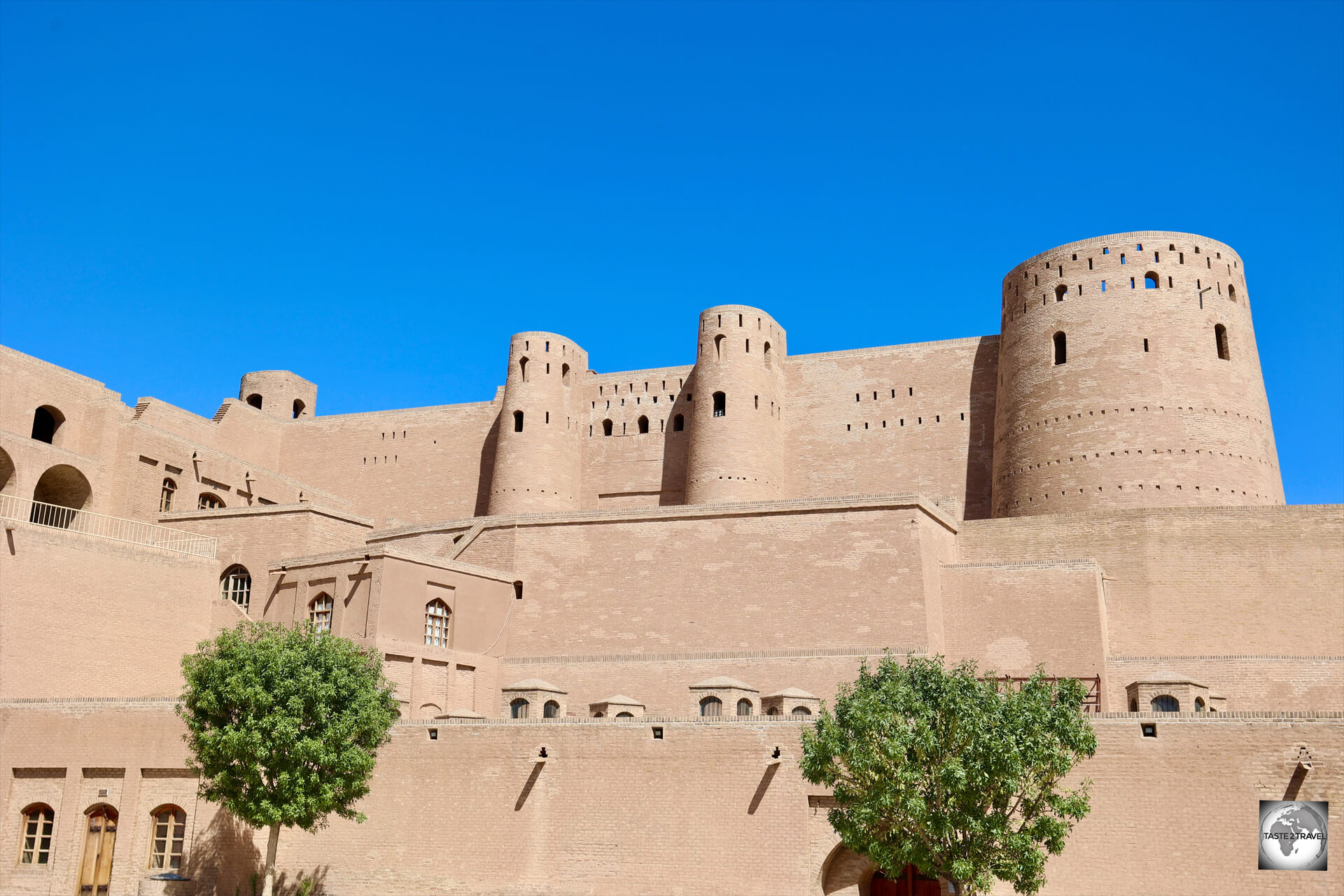
An iconic sight in Herat, the imposing Citadel of Herat, also known as the Citadel of Alexander.
The Citadel of Herat, also known as the Citadel of Alexander, is located in the centre of Herat in Afghanistan.

The impressive Citadel was constructed by Alexander the Great, who arrived in Herat in 330 BC.
It dates back to 330 BC, when Alexander the Great and his army arrived to what is now Afghanistan after the Battle of Gaugamela.

Damaged by decades of war, the citadel was completely renovated from 2006 to 2011.
Many empires have used it as a headquarters in the last 2,000 years, and it was destroyed and rebuilt many times over the centuries.

The oldest building in Herat, the citadel is believed to stand on the foundations of a fort built by Alexander the Great.
The citadel is built on an artificial mound and stretches 250m east to west. Its 18 towers rise over 30m above street level, with walls 2m thick.
The present structure was largely built by Shah Rukh in 1415, after Timur trashed what little Genghis Khan had left standing.

Fragments of tiles, which once featured a poem, can be seen on the northwest wall, the so-called ‘Timurid Tower’.
The exterior of the citadel was once covered with tiles which featured Kufic script, with a poem proclaiming the castle’s grandeur. Today, fragments of these tiles can be seen on the northwest wall, the so-called ‘Timurid Tower’.

Exploring Herat Citadel.
Khwaja Abdullah Ansari Shrine

A view of the shrine of Khwaja Abdullah Ansari.
Located in Herat, Khwaja Abdullah Ansari Shrine is the funerary compound of the Sufi saint Khwaja Abdullah Ansari.

The shrine of Khwaja Abdullah Ansari.
The shrine was erected in 1425, under the patronage of Shah Rukh, the ruler of the Timurid dynasty.

A detailed view of one of the Iwans at the Shrine of Khwaja Abdullah Ansari complex.
He commissioned the site as a memorial mausoleum for patron-saint Khwaja Abdullah Ansari who was a Sufi mystic and patron saint of Herat.

The shrine of Khwaja Abdullah Ansari is surrounded by the tombs of other Islamic elites.
Surrounding the mausoleum are the tombs of many local Islamic elites, who wished to be buried alongside the revered Sufi saint.

Tombs at the Shrine of Khwaja Abdullah Ansari are installed everywhere, including inside the Iwans.
Musallah Minarets of Herat

Four of the five, 55-metre-high, 15th century, Musallah Minarets of Herat.
The Musalla complex, also known as the Musalla of Gawhar Shah, is a former Islamic religious complex located in the suburbs of Herat.
The complex contains examples of Timurid architecture, much of which lies in ruin.
Shah Rukh, the ruler of the Timurid Empire, made Herat the capital of his empire in 1405, moving it from Samarkand.
Construction on the complex began in 1417 under Queen Gawharshad, the wife of Timurid ruler Shah Rukh.
Towering above the surrounding neighbourhood are 5 impressive, 55-metre-high minarets which date from the 15th Century (CE).
During the Panjdeh incident of 1885, Russian soldiers attacked Afghan soldiers southeast of Merv. Most of the buildings in the complex were leveled by the British and Emir Abdur Rahman Khan in order to prevent the Russians from using the buildings as cover.
Only the Gawhar Shad Mausoleum and nine of the original twenty minarets were allowed to remain.

A view of the Gawhar Shad Mausoleum in Herat.
The complex is also home to the Gawhar Shad Mausoleum and the Mausoleum of Ali-Shir Nava’i which was rebuilt in 1955.
Gawhar Shad Mausoleum

A view of the dilapidated dome of the Gawhar Shad Mausoleum.
The Gawhar Shad Mausoleum, also known as the Tomb of Baysunghur, is an Islamic burial structure located in the Musalla complex.

The smallest tombstone belongs to the infant Prince Baysunghur.
Built in the 15th century, the structure served as a royal tomb for members of the Timurid dynasty and was originally built as a mausoleum for the young Prince Baysunghur, a son of the Timurid ruler Shah Rukh.

A view of the ceiling of the Gawhar Shad Mausoleum in Herat.
The mausoleum forms a cruciform shape, with a dome covering the centre. This dome is the most impressive feature of the structure, in that it is actually three domes superimposed over one another: a low inner dome, a bulbous outer cupola and a structural dome between them.

A view of the front entrance of the Gawhar Shad Mausoleum.
Mausoleum of Ali-Shir Nava’i

The rebuilt Mausoleum of Ali-Shir Nava’i in Herat.
Located next to the Gawhar Shad Mausoleum is the Mausoleum of Ali-Shir Nava’i, who was one of the most influential Timurid nobles of Herat.
Alisher Nava’i was born in 1441, in Herat, to a family of well-read Turkic chancery scribes.
During Alisher’s lifetime, Herat was ruled by the Timurid Empire and became one of the leading cultural and intellectual centres in the Muslim world.

Interior view of the Mausoleum of Ali-Shir Nava’i in Herat.
Alisher belonged to the Chaghatai mir class of the Timurid elite. He was a protagonist of the Chaghatai Turki language and a great patron of the arts.
Because of his distinguished Chaghatai language poetry, Nava’i is considered by many throughout the Turkic-speaking world, to be the founder of early Turkic literature.
Many places and institutions in Central Asia are named after him.
Herat Jihad Museum

The Jihad Museum in Herat details Afghanistan’s struggle against the Soviet invasion in the 70’s and 80’s.
Located on the outskirts of Herat, the Jihad Museum was built in 2010 as a place for Afghans to understand past conflicts and their history.
The museum seeks to inform visitors of the mujahideen’s resistance and to educate Afghans.
It is a memorial to the mujahideen who fought the Soviets in the 70s and 80s as well as to the Afghans who lost their lives fighting.
The museum is designed as a blue, green and white rotunda. The outside of the building is inscribed with some of the names of victims of the war, both men and women.

A captured Soviet tank and a fighter jet, on display at the Jihad Museum.
Located in a park on a hilltop, the Jihad Museum is surrounded by a garden with flowers and fountains and captured Soviet military equipment, including tanks, a fighter jet and helicopters.
Inside, the museum exhibits a large collection of Russian rifles, grenades and plastic land mines on display.

The ‘Portrait Hall of Fame’ displays portraits of over 60 Afghan commanders who fought the Soviets.
The Portrait Hall of Fame displays portraits of over 60 Afghan commanders who fought the Soviets.

A highlight of the Jihad Museum is a 360° diorama which depicts Afghan villagers rising up against Soviet soldiers.
The highlight is the amazing 360° diorama which depicts Afghan villagers rising up against Soviet soldiers. The stages of battles end in a mujahideen victory and the eventual Soviet withdrawal from Afghanistan.

A gallery of Afghan commanders.
The museum provides a fascinating insight into a dark period of Afghanistan’s history.
Herat Bazaar

Colourful, hand-woven, rolls of textiles at a shop inside Herat bazaar.
Herat is home to one of the oldest and largest bazaars in Asia.

Faux-gold bangles for sale at Herat bazaar.
Sprawling around the Great Mosque of Herat, this bustling market is a treasure trove of traditional Afghan crafts, spices, exquisite carpets, hand-woven textiles and so much more.

A spice seller at Herat bazaar.
Herat Bazaar is a great place to buy souvenirs and gifts that reflect Afghan culture and heritage. Many shops sell Afghan antique items at very reasonable prices.

Traditional children’s clothing for sale at Herat bazaar.
Herat Bazaar is renowned for its rich cultural heritage, vibrant atmosphere, and the diverse range of goods and products it offers to both locals and visitors.

“Afghanistan” souvenir fridge magnets on sale at Herat bazaar.
The bazaar has a long history dating back to ancient times. It has been a prominent trading hub along the Silk Road, connecting Asia, the Middle East, and Europe.

Souvenirs of Afghanistan at Herat bazaar.
While there is plenty of shopping to be done at the bazaar, a visit is more of a cultural experience and a great opportunity to interact with local Heratis who are renowned for their warm hospitality.
Bamyan

A place of incredible natural beauty, Bamyan is known for its giant Buddha statues which were, unfortunately, destroyed by the Taliban in 2001.
Tucked away amidst the rugged central highlands of Afghanistan lies the enchanting Bamiyan Valley, a place where history, culture, and natural beauty converge.

A view of the Bamyan Valley, from the Eastern Buddha.
Bamyan Province is situated in the central part of Afghanistan, approximately 230 kilometres (143 mi) west of the capital, Kabul. It is surrounded by the Hindu Kush mountain range.

A view of the sandstone cliff at Bamyan, and the niche of the larger Western Buddha.
Known for its (now destroyed) giant Buddha statues, stunning landscapes, and warm hospitality, Bamiyan beckons intrepid travelers to explore its hidden treasures.
The Buddhas of Bamiyan

A young Afghan hipster, in front of the Eastern Buddha niche.
The once colossal Buddha statues were carved into the sandstone cliffs of the Bamiyan Valley, over 1,500 years ago. At the time, these statues were among the largest standing Buddhas in the world.
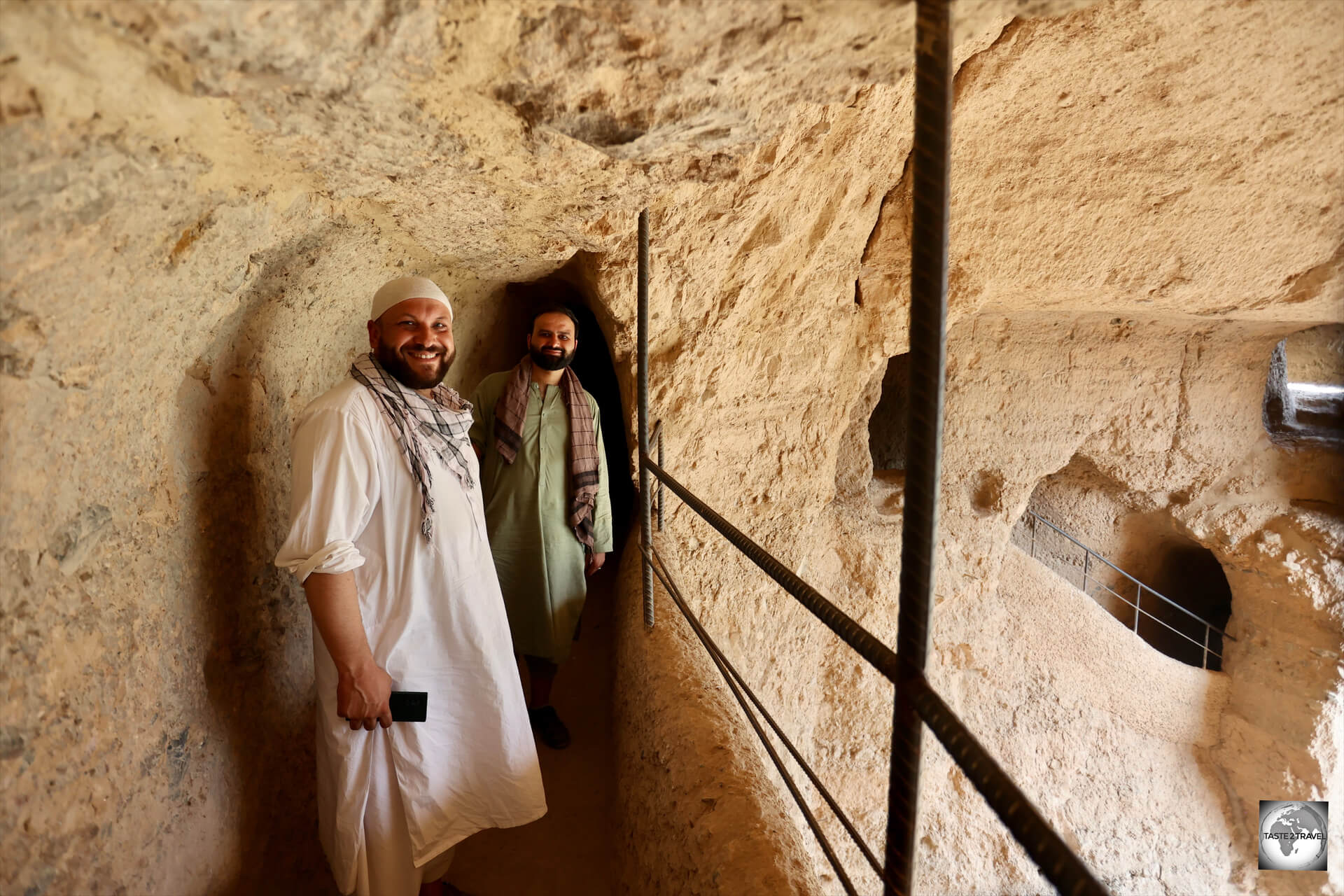
Exploring one of the niches of the (former) giant Buddhas at Bamyan with my guide, Jamshyd Aryan, and our driver, Omar.
Carbon dating of the structural components of the Buddhas has determined that the smaller 38 m (125 ft) “Eastern Buddha” was built around 570 CE, and the larger 55 m (180 ft) “Western Buddha” was built around 618 CE.
The intricate details and features of the Buddhas showcased the craftsmanship and artistic abilities of the ancient Bamiyan people.

One of many niches carved into the cliff, which feature dome ceilings and carved walls.
Also lining the cliff are numerous other niches which once contained smaller statues. Some of the niches feature intricately carved walls and domed ceilings.

The empty niche, which was once occupied by the Western Buddha at Bamyan.
On orders from Taliban founder Mullah Omar, the statues were destroyed in March 2001, after the Taliban government declared that they were un-Islamic and idolatrous. International and local opinion strongly condemned the destruction of the Buddha

Fragments, from the destroyed Western Buddha, have been covered, pending future restoration.
Today, visitors can view the empty niches and large fragments of the destroyed buddhas which are housed in protective shelters.
Since the destruction of the Buddhas of Bamyan, there have been international efforts to document and reconstruct these iconic statues in some form. However, the process has been fraught with challenges due to the political and security situation in Afghanistan.

A precipitous staircase, carved into the sides of the cliff, allows visitors to climb up and over the smaller Eastern Buddha.
A precipitous staircase allows visitors to climb up and over the smaller Eastern Buddha. The views of the Bamiyan countryside, from the top of the Buddha, are spectacular.

A view of the Bamyan Valley, from the top of the Eastern Buddha.
The steep climb to the top of the Eastern Buddha provides an unforgettable, panoramic view of the very green Bamyan Valley.

The empty niche, which was once occupied by the Eastern Buddha at Bamyan.
The Buddhas of Bamyan were once iconic symbols of Afghanistan’s cultural and religious diversity. Their destruction remains a somber reminder of the impact of ideological extremism on cultural heritage and the need to preserve such treasures for future generations.
Shahr-e Gholghola (The City of Screams)

A view of Shahr-e Gholghola, also known as the “City of Screams”.
Located on the opposite side of the valley to the Buddhas, Shahr-e Gholghola is a UNESCO World Heritage Site which is more famously known as the “City of Screams“.

A view of Bamyan from the City of Screams.
Once the centre of Bamyan, this ancient mudbrick settlement was besieged by Mongol invaders during Genghis Khan’s invasion in the 13th century.

A view of Bamyan, from the City of Screams.
During the fighting, Mutukan, the favourite grandson of Genghis Khan, was killed by an arrow fired from the besieged walls of the city.
This, naturally, upset Genghis, who then ordered the entire population to be massacred, which gave the city its famous moniker – “City of Screams”.

An old watch tower overlooks Bamyan Valley at the City of Screams.
Journey to Bamyan

The main highway from Kabul to Bamyan, winds its way through the central highlands of Afghanistan.
The road journey from Kabul to Bamyan is a picturesque and adventurous drive through the heart of the country, offering stunning views of rugged mountains, deep valleys, and historical sites along the way.

On the road to Bamyan from Kabul on the northern route.
There are two possible routes between Kabul and Bamyan, both are incredibly scenic, passing through the central highlands and the Hindu Kush:
- The southern route, which involves a journey of 3 hours 38 minutes (180.6 km), via the Kabul-Behsud Highway.
- The northern route, which involves a journey of 4 hours 25 minutes (232 km), via the A77.

The northern route passes through a narrow gorge in the Hindu Kush.
Not too long ago, the road journey from Kabul to Bamyan would have been considered too risky due to the risk of kidnapping and improvised explosive device (IED) attacks.
Today, with the former insurgents now in government, all is calm!

Mineral rich, fresh mountain water, has stained the rocks in this roadside gorge.
Accommodation
All of the following accommodation options were pre-booked, by a tour company, as part of my tour package to Afghanistan.
Kabul

My spacious, windowless, room at the Kabul City Walk Hotel.
While in Kabul, I stayed at the centrally located Kabul City Walk Hotel. While some rooms feature windows, I was always assigned a windowless room.
As is typical in Afghanistan, this hotel has awarded itself 4-stars, but, in the real world, it would be a 2-star hotel!
Like most buildings in Afghanistan, the entrance to the hotel is fortified, with guests entering off the street, through an attack-proof annex where all bags are searched by hand – including turning on your camera to prove that it’s a camera. Also included for good measure is a body pat-down, before you proceed through a metal detector.

Breakfast at the Kabul City Walk Hotel.
A decent buffet breakfast is offered each morning in the restaurant on the 9th floor. For those who are staying in windowless rooms, the restaurant offers panoramic views of Kabul.
The staff at the Kabul City Walk Hotel were friendly and professional, and the service was good. The hotel served as my base during my visit to Afghanistan.
Mazar-i-Sharif

The old and dated, Sameer Waleed Guest House in Mazar-i-Sharif.
While in Mazar, I stayed at the less-than-impressive, Sameer Waleed Guest House.
While my tour package included hotel accommodation, I somehow ended up in this old and faded, downbeat guest house. There are many other better options in Mazar.
Tip: When booking a tour, you should ask which hotels you will be accommodated in so that you can pre-check and avoid any disappointment.

My old and dated room at the Sameer Waleed Guest House in Mazar-i-Sharif.
The guest house, which is primarily used by visiting local families, features old and dated rooms with very uncomfortable beds.
Breakfast was served each morning in my room and consisted of a piece of bread, a packet of jam and two teas bags.
Best to stay elsewhere!
Herat
In Herat, I stayed at the Nazary Hotel, which like the Kabul City Walk Hotel, displays 4-stars, but would be rated as a 2-star hotel in the real world.
Comfortable and spacious rooms offer views of downtown Herat while a buffet breakfast is served on the top floor.
Like other hotels in Afghanistan, security is tight, with guests first entering the hotel through a secure annex, where all luggage is thoroughly searched and a body pat-down is done. From the annex, you then proceed to reception.
Bamyan
In Bamyan, I stayed at the Bamyan Royal Hotel, which is one of the better hotels in town, with each room offering a balcony with a view to the Bamyan Buddhas.
Like most hotels in Afghanistan, the Bamyan Royal Hotel offers dated, but decent, rooms, with a complimentary breakfast served in the ground floor restaurant.
Unlike other hotels in the country, security here is more relaxed, with security guards on the main gate performing a cursory check of any vehicles entering the property.
Eating Out

Enjoying a typical Afghan lunch with my guide, Jamshyd (left) and my driver, Jaleel, at the Jumairah restaurant in Kabul.
Cuisine
Afghan cuisine is a rich and diverse culinary tradition that reflects the country’s history, geography, location and cultural influences.
It has been shaped by a blend of Persian, Indian, Central Asian, and Middle Eastern flavors, resulting in a unique and flavourful array of dishes.

Enjoying a plate of Kabuli Pulao in Kabul.
Afghan cuisine often features rice dishes, with the most famous being Kabuli Pulao. This dish consists of aromatic long-grain rice cooked with lamb or beef, carrots, and raisins, garnished with nuts.
Afghan bread, known as naan, is a staple in the Afghan diet. It’s typically baked in a tandoor oven and can be round or oblong in shape. One of the best breads in Afghanistan is Naan Mazari.
Naan Mazari
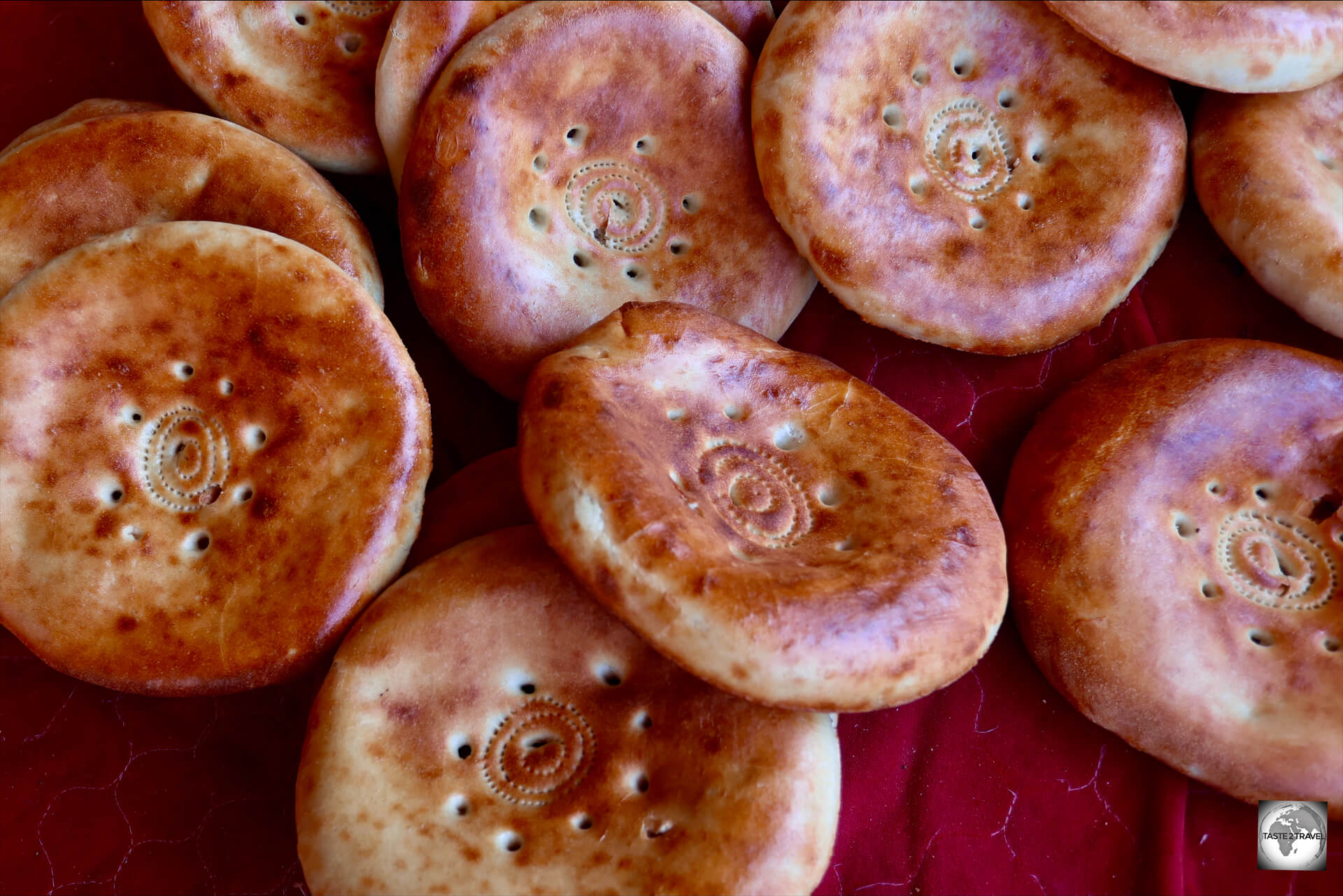
Freshly baked Naan Mazari.
Naan Mazari is a special type of bread from North Afghanistan, specifically Mazar-i-Sharif.
To those who have travelled in Central Asia, or Western China, this style of bread will be very familiar.

Naan Mazari is baked in a clay, tandoor, oven.
Naan Mazari is first shaped by the baker with a unique pattern imprinted into the top of the bread.

Naan Mazari baking inside a tandoor oven.
The bread is then baked inside a clay tandoor oven until it’s golden brown.

A kebab meal, at the Bilal restaurant in Mazar-i-Sharif, is served with freshly baked Naan Mazari.
Many restaurants in Mazar-i-Sharif, including the very good Bilal restaurant, have their own in-house bakeries and will always serve their meals with freshly baked Naan Mazari.
As for meat, lamb and chicken are the most commonly consumed meats, with goat and beef also being popular choices.
Meat is invariably cooked in the form of kebabs and always served with bread and a side salad of tomato and cucumber. Kebabs are often marinated in yogurt and spices before grilling.

An amazing cup of Doogh, served at a restaurant in Mazar-i-Sharif.
Doogh is a popular, traditional, yogurt-based drink, sometimes flavored with mint and served cold. This is also known as Ayran in Turkey and throughout Central Asia. A very tasty complement to any meal!
Mantu

One of my favourite dishes in Afghanistan – Mantu.
Steamed dumplings are a popular staple throughout Central Asia, including in Kazakhstan, Uzbekistan, Tajikistan, Turkmenistan and Kyrgyzstan (click to read my travel guides for those countries), where they are known as Manty.
However, in my humble opinion, the best steamed dumplings are served in Afghanistan, where they are known as Mantu.
Mantu is a thin dough that is filled with beef, or lamb, mixed in onions and spices.
What sets Afghan Mantu apart is the orange topping sauce, which is made from chaka (thick creamy strained yogurt), mixed with lentils.
This sauce is missing in the other countries and certainly complements the Mantu perfectly!
Being a huge country, with a diverse population, and located at a crossroads in Asia, Afghan cuisine varies from region to region due to local influences.
Overall, Afghan cuisine offers a wide range of flavours and dishes, making it a fascinating and delicious aspect of Afghan culture.
Restaurants /Cafés
Kabul

Excellent Afghan cuisine is served at the Bukhara Restaurant in downtown Kabul.
There are many fine restaurants in Kabul, including the excellent Bukhara restaurant, The Cafeteria and the Jumairah restaurant. All of these restaurants are located in close proximity to each other.
Mazar-i-Sharif

Sharing dinner with Munir and Hamid, my guide (left) and driver, at Bilal Restaurant in Mazar.
Mazar-i-Sharif is the food capital of Afghanistan, with Afghans flocking here to sample the many delectable offerings from amazing Sheer Yakh (Afghan Kulfi ice cream), to the delicious, always freshly baked, Naan Mazari bread – both of which are featured below.

A specialty of the Bilal restaurant is a plate of succulent grilled lamb, served with salad.
There are many fine restaurants in Mazar, however, repeat visits were made to the excellent, and always busy, Bilal restaurant where I enjoyed delicious meals with my guide, Munir and driver, Hamid.
The restaurant is very popular with local Taliban officials who always dine alongside their, fully loaded, AK-47s. No photos allowed!

Sharing mutton kebabs for lunch, with my guide, Munir, in Mazar-i-Sharif.
Mazar-i-Sharif is known for its exquisite melons. Melons are sold everywhere, piled high on the side of the street. When I flew back to Kabul, many passengers carried melons with them on the flight.
Sheer Yakh

A master maker of Sheer Yakh – Afghan Kulfi ice cream – in Balkh.
Both Mazar-i-Sharif and Balkh are famous for Sheer Yakh – an Afghan kulfi ice cream.
There are many roadside ice cream cafes in both towns, where you can watch the masters of Sheer Yakh perform their magic.
Sheer Yakh, meaning frozen milk or cold milk in Dari, is a traditional Afghan dessert that uses the same ingredients as the Indian kulfi ice cream, but is prepared differently.

My driver, Hamid, about to enjoy a monumental plate of Sheer Yakh in Balkh.
The ice cream ingredients such as milk, sugar, and flavorings are all added to a metal container, which is then placed inside another metal container filled with ice and salt.
The person who makes the ice cream continuously rotates the vessel holding the ingredients manually within the stationary ice-filled container and occasionally stirs the creamy mixture until it becomes frozen.
Video: A master ice cream maker in Balkh, preparing Sheer Yakh!
Typical flavorings include cardamom, rose water, and salep (wild orchid powder).

A plate of divine, Sheer Yakh, made from fresh mangoes, served in an ice cream shop in Mazar-i-Sharif.
A favorite summertime street food item, Sheer Yakh is usually served in small bowls and topped with chopped pistachios, almonds, and thick cream.
Video: My driver, Hamid, pouring a thickened cream mix over a monumental construction of Sheer Yakh in Balkh!
Herat
While I ate more standard Afghan cuisine in Herat, the standout offering for me was the excellent coffee served at Afghan Coffee which is hidden away inside a small shopping mall, opposite Farhang park in downtown Herat.
This was the best coffee I found in Afghanistan, which is a staunch tea-drinking nation.
Unfortunately, the Taliban have banned women from entering coffee shops!
Headless Mannequins: In the same shopping mall, the heads of all mannequins, in the different clothing shops, have been removed on the orders of the Taliban who considered a mannequin with a head to be an idol!
Bamyan

The Shamama Restaurant in Bamyan served the most succulent chicken for dinner.
Located in downtown Bamyan, the Shamama Restaurant offers typical Afghan cuisine in a family-friendly environment. They have even installed a children’s indoor playground in one of their many rooms.
The name of the restaurant is derived from Shamama – The Queen Mother Buddha of Bamiyan!
I especially recommend their grilled chicken, which is coated in spiced yoghurt! Truly divine!
Visa Requirements
Visa Policy

The Visa Policy Map of Afghanistan is full of grey, with every nationality requiring a visa in advance.
Source: Wikipedia.
Citizens of all countries require a visa to visit Afghanistan. The only exemptions are travellers born in Afghanistan, born to Afghan parents or with parents born in Afghanistan.
Following the 2021 takeover of the country by the Taliban, diplomatic missions of Afghanistan set up by the former government, the Islamic Republic of Afghanistan, were instructed by the Taliban to continue their work, and the Taliban government is accepting visas issued by these missions for entry into Afghanistan.
Some missions have stopped issuing visas, while others have continued to issue them.
Tourist Visas

My visa for Afghanistan was issued at the Afghanistan Embassy in Abu Dhabi, and was valid for 30 days.
I obtained my tourist visa, without fuss, at the Embassy of Afghanistan in Abu Dhabi (click to view map location), which still flies the official, tri-colour, Afghan national flag.
Also in the UAE, visas can be obtained from the Consulate General of Afghanistan in Dubai (click to view map location), which also flies the tri-colour flag. The Dubai consulate is located a short, 300-metre walk from the ‘Max‘ metro station.
Currently, tourist visas are issued to those travellers who have a Letter of Invitation (LOI) from an Afghanistan-registered tour company.
In addition to the letter of invitation, you might be asked to provide a copy of the official trading license of the tour company. This is issued by the Afghanistan Department of Culture, to registered tour operators in Afghanistan.
Visas are generally issued on the same day, are valid for a stay of 30 days, and cost around US$150.
Foreigner Registration

Issued at Kabul International Airport, the Foreigner Registration card must be carried at all times.
Upon arrival at Kabul International Airport, all foreigners are required to register at a registration desk inside the immigration hall.
In order to register, you’ll need to complete an A4-size form, which is almost like a 2nd visa application form, and you’ll need to provide 2 passport photos.
Important: You should ensure you have 2 passport photos with you as there is no facility at the airport for taking photos.
A similar registration process is also required upon arrival at Mazar-i-Sharif airport – even for domestic arrivals.
Tourist Travel Authorisation Process

My ‘Travel Authorisation’ letter which was issued by the Department of Culture in Kabul.
One important consideration for visitors to Afghanistan is the current (Taliban imposed) requirement that all tourists apply for a ‘travel authorisation‘ in each province they visit.
Before you start any sightseeing in a new province, you must first visit the provincial office of the Department of Culture and secure a written travel authorisation, which allows you to travel around the province and visit the different sights. This process will be handled by your guide.
Without this travel authorisation, you will be refused entry to sights!
This travel authorisation must be carried everywhere you go and will always be requested at road checkpoints, tourist sights and many other places.

My travel authorisation for Mazar-i-Sharif was handwritten on the same document as my Kabul authorisation.
This process is time consuming and involves meetings with Taliban government officials. I was always treated with respect and made to feel welcome.
It’s important to note that government offices are closed for the weekend (Thursday afternoon and all-day Friday), so you should avoid arriving in a new province during the weekend.
I arrived in Mazar-i-Sharif on a Friday afternoon, when the local registration office was closed. I had to remain in my hotel until I could register on Saturday morning.

My travel authorisation document which was issued in Herat.
When I arrived in Herat, it was 4 pm which is the closing time of the Department of Culture. My guide, who was friends with the staff in the office, had arranged for them to remain open until I had been processed.
The staff kept the office open, and were waiting for us when we arrived at 4:30 pm. I was processed speedily and was then free to explore the many sights of Herat.
During my registration process with the Department of Culture in Kabul, I met with the Deputy Minister of Tourism, who certainly was the friendly face of the Taliban!
He warmly welcomed me to Afghanistan, and offered a complementary visa extension, should I require more time in the country.
The minister, who encouraged me to stay as long as I wished, was very welcoming and said that he hoped to see more tourists visiting Afghanistan in the future.
Getting There

“I Love Afghanistan” sign at Kabul International Airport.
Air
Currently, no international airlines are flying to Afghanistan.

Airport shuttle bus at Kabul International Airport.
Flights to the country are operated by two Afghan airlines – the government owned (and totally unreliable) Ariana Afghan Airlines (referred to locally as simply AAA), and the much more reliable, privately owned, Kam Air.

The current (September 2023) Kam Air route map.
Of the two Afghan airlines, I would recommend Kam Air, which is the largest private Afghan airline. A typical return airfare from Dubai to Kabul with Kam Air costs around US$700.
I flew with Kam Air, return, from Dubai to Kabul and also from Kabul to Mazar-i-Sharif.

My boarding pass for my Kam Air flight from Dubai to Kabul.
Founded in 2003, Kam Air has twelve aircraft, operating scheduled domestic passenger services throughout Afghanistan and international services to destinations in Central Asia, South Asia, and the Middle East.

When flying to, from and within Afghanistan, Kam Air is the preferred airline.
Kam Air planes are configured with all economy seats, while AAA offers some business class seats on a few of its planes.
Both airlines are flying very old planes.
On one flight with AAA, I found myself in row 2 of an all-economy configuration, flying on a very old Airbus A310. One of the first Airbus’ to be produced, this particular aircraft was manufactured in the early 1980’s.
During the safety demonstration we were advised that cassette players were not to be used during the flight! Welcome to Afghanistan!

Kam Air flies daily to Kabul from Terminal 1 at Dubai International Airport.
The following airlines operate scheduled services to/from Kabul International Airport:
- Ariana Afghan Airlines – flies to/ from: Al Ain, Delhi, Doha, Dubai–International, Herat, Islamabad, Kandahar, Mashhad, Mazar-i-Sharif, Moscow–Sheremetyevo, Tehran–Imam Khomeini.
- Kam Air – flies to/ from: Abu Dhabi, Ankara, Bamyan, Chaghcharan, Delhi, Dubai–International, Dushanbe, Herat, Islamabad, Jeddah, Kandahar, Khost, Kunduz, Kuwait City, Lashkargah, Maymana, Mazar-i-Sharif, Medina, Najaf, Sharjah, Tarinkot, Tashkent

The privately owned Kam Air is the more reliable of the two Afghan airlines.
Airport Arrival Procedure
Due to the unique security situation in Afghanistan, arriving at an Afghan airport is a different experience, compared to most other countries.
At all airports, no member of the public, including tour company staff, are allowed anywhere near the terminal. All members of the public must wait in the airport car park, which is always located near the front gate of the airport.
At Kabul airport, the car park is located about 300 metres from the International terminal. When you first exit the terminal, you will not find anyone waiting for you. You must instead walk to the car park at the front of the airport.
Airport Departure Procedure
Departing from an Afghan airport is also different to anywhere else in the world. Due to security concerns, the many security screenings are first performed away from the airport terminal.
As an example:
To gain access to Kabul International Airport, all vehicles are required to line up outside the airport gate. Passengers then walk through the first security checkpoint where you are subject to a body pat-down and a manual search of all bags (including turning cameras on to prove that they are cameras).
At this checkpoint you line up for a long time since one security staff is manually checking all passenger bags!After exiting the 1st checkpoint, you then walk 200 metres to the 2nd checkpoint – another body pat-down with all bags x-rayed.After this, you then walk another 200 metres to the entrance of the terminal where you join another long line for yet another body pat-down and all bags x-rayed for a 2nd time.
About 30 minutes after arriving at the airport, you finally get to enter the terminal to check-in! Once you have checked in, you then proceed to the regular airport security screening – the 4th security check!
Airport Transport
All arriving tourists will be met in the car park of each airport by their guide and driver.
If you require a taxi, you’ll find plenty of them waiting in the airport car parks.
Land
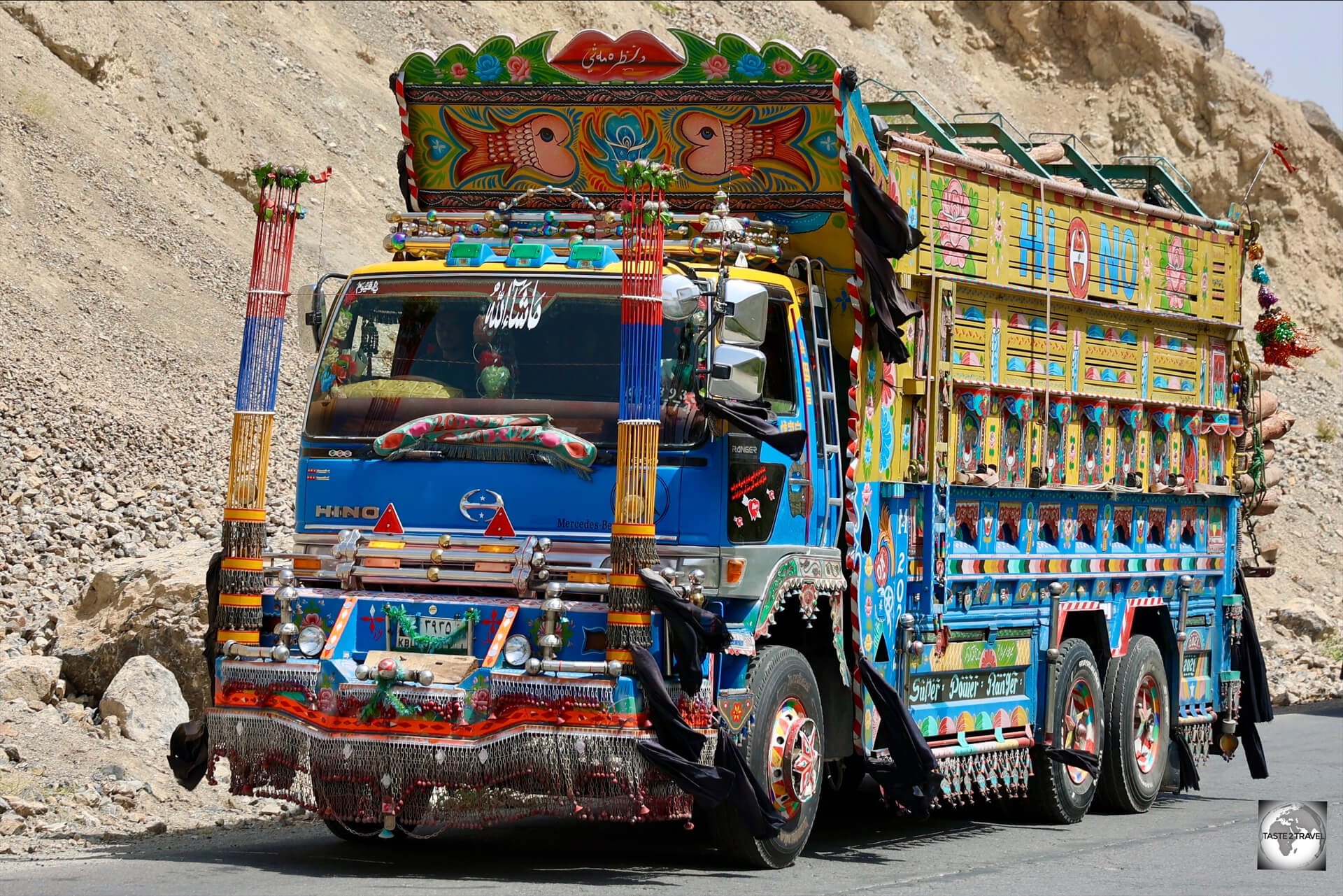
Trucks in Afghanistan are highly decorated and always very colourful.
Located at an Asian crossroads, Afghanistan shares land borders with six countries:
Pakistan: Afghanistan’s eastern border is approximately 2,430 kilometres (1,510 miles) long, making it the longest border of Afghanistan. This border stretches from the northern region of Pakistan, near the Wakhan Corridor, to the southern border with Pakistan’s Balochistan province.
Iran: Afghanistan shares a western border with Iran, which is approximately 936 kilometres (582 miles) long. This border extends from the northeastern part of Iran to Afghanistan’s western provinces.
Turkmenistan: The northern border of Afghanistan with Turkmenistan is roughly 804 kilometres (500 miles) long. It runs through the northern provinces of Afghanistan.
Uzbekistan: Afghanistan’s border with Uzbekistan is around 144 kilometres (90 miles) long, situated in the northern part of the country.
Tajikistan: Afghanistan’s northeastern border with Tajikistan is approximately 1,206 kilometres (749 miles) long. This border passes through the rugged terrain of the Hindu Kush mountains.
China: Afghanistan’s easternmost border is shared with China’s Xinjiang region. The border with China is about 76 kilometres (47 miles) long and is located in the narrow Wakhan Corridor.
Afghanistan’s neighbours have a tendency to shut their land borders in times of trouble. Prior to travelling to a land border, you should first confirm whether or not it’s possible to cross the border.
Getting Around

Boarding my Kam Air flight to Mazar-i-Sharif.
Air

Boarding my Ariana Afghan Airlines flight to Herat.
Due to the appalling state of the roads in Afghanistan, flying is the preferred choice of travel for many Afghans.
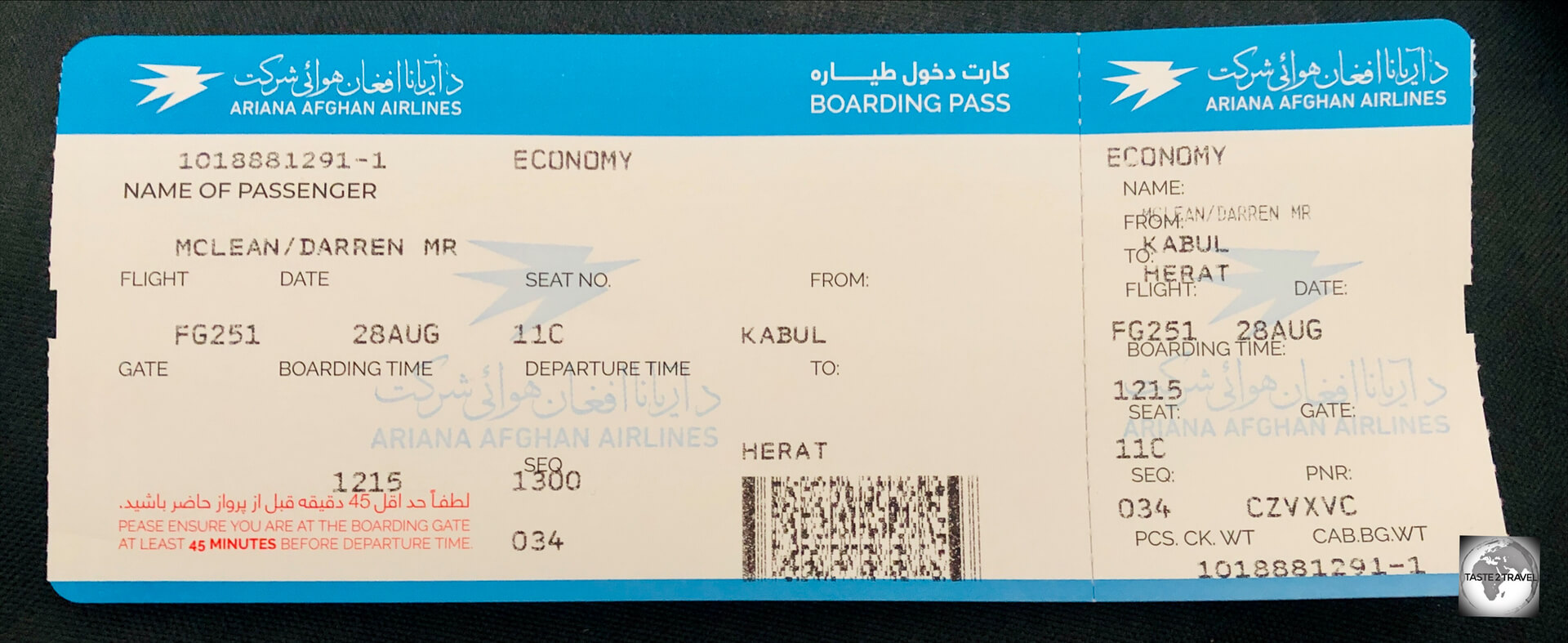
My boarding pass with Ariana Afghan Airlines, for my flight from Kabul to Herat.
The road journey between Kabul and Mazar-i-Sharif is 427 km but takes 9 hours, versus a 50-minute flight!
I flew on two (return) domestic flights which were included in my tour package – Kabul to Mazar-i-Sharif and Kabul to Herat. All domestic flights operate to/ from Kabul Airport.

Mazar-e-Sharif International Airport, officially called Mawlana Jalaluddin Mohammad Balkhi International Airport.
I flew to Mazar with Kam Air who were reasonably punctual.

Herat International Airport, also known as Khwaja Abdullah Ansari International Airport.
However, my flights to Herat were operated by AAA (Ariana Afghan Airlines) who delayed my return flight by 7 hours, without any advance notification being given.

My Kam Air boarding pass, for my flight from Mazar-i-Sharif to Kabul.
A typical return airfare on Kam Air from Kabul to Mazar costs around US$130, while a return flight from Kabul to Herat costs around US$160.
Public Transport

Travelling from Bamyan to Kabul.
There are plenty of long distance shared-taxis and buses operating in Afghanistan.
However, for security reasons, visitors will be assigned a private vehicle with a guide and driver.
Taxi

I toured the sights of Balkh in a taxi, accompanied by my guide and a driver.
Taxis, which are all painted yellow and white, are plentiful in all the major urban centres.
Prices should be negotiated in advance.
That’s the end of my Afghanistan Travel Guide.
If you wish to provide feedback, you can do so using the ‘comments’ form below.
Safe Travels!
Darren
Other Taste2travel Travel Guides from the region:
Author: Darren McLean
Darren McLean is an Australian, full-time, digital nomad who has spent 37 years on a slow meander around the globe, visiting all seven continents, 192/ 193 UN countries and 245/ 251 UN+ countries and territories.
He founded taste2travel to pique one’s curiosity and inspire wanderlust.







